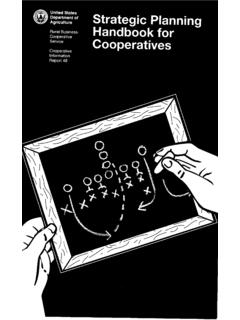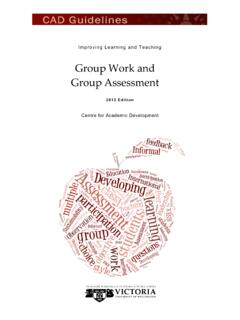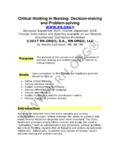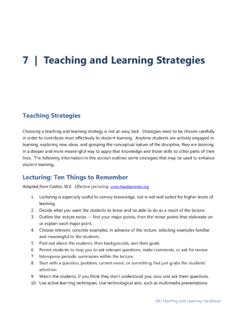Transcription of Competency-Based Organizational Development Strategy
1 1111 Competency-Based Human Resource Development Strategy Noordeen T. Gangani Gary N. McLean University of Minnesota Richard A. Braden West group This paper explores issues in developing and implementing a Competency-Based human resource Development Strategy . The paper summarizes a literature review on how competency models can improve HR performance. A case study is presented of American Medical Systems (AMS), a mid-sized health-care and medical device company, where the model is being used to improve employee performance and gain a competitive advantage. While there are numerous benefits from using behavior-based competency models, there are also some challenges. Keywords: Competency Models, Performance Improvement, Organization Development Competency-Based practices are popular among large and mid-sized employers as an integral tool for talent selection, retention, and Development .
2 Competencies describe the skills, knowledge, behaviors, personal characteristics, and motivations associated with success in a job. Competency-Based practices utilize a competency framework to align the strategic objectives of an organization with its key HR business processes. By applying a systematic approach of measuring individual competencies, it may be possible for an organization to build ongoing snapshots of the overall knowledge capital and skills portfolio of its workforce. Further, organizations may be able to utilize this information to perform individual and Organizational analysis, reduce education costs, improve hiring practices, improve retention, improve human resources performance and developmental planning processes, and deploy its human capital more effectively. Although competencies could be used in various HR functions, the focus of this paper is on staffing and selection, education and training, career Development , and performance management.
3 Purpose Statement The use of a competency method as the basis for human resource management has become widespread in the United States and is gaining a foothold in international HR practice (Athey & Orth, 1999). In today s competitive and constantly changing business environment, competency models may be able to help human resource professionals improve the skills set and efficiency level of their workforce to match changing market trends, in order to face competitive business challenges. This paper highlights some of the major issues of Competency-Based Strategy , with a particular focus on the Development and implementation of competency models. The intended outcome of this literature review and case study is to build a conceptual framework for further research regarding the extent to which competencies could be applicable in various HR and HRD functions.
4 Theoretical Framework Competencies have many definitions (see the Review of the Literature). A frequently used definition is, A descriptive tool that identifies the skills, knowledge, personal characteristics, and behaviors needed to effectively perform a role in the organization and help the business meet its strategic objectives (Lucia & Lespinger, 1999, p. 5). Ranging from selection, retention, and Development to Organizational strategic planning, competencies are used today in a wide range of functions within human resources (Rodriguez et al., 2002). However, the decision to introduce a competency model into an organization should not be made without due consideration. Organizations will need to devote a significant amount of time for planning and communication, data collection, change planning, and resistance management. This paper highlights some of the issues that HR and HRD professionals may come across while developing and implementing Competency-Based HRD Strategy .
5 Copyright 2004 Noordeen T. Gangani, Gary N. McLean, & Richard A. Braden 51-2 1112 Research Questions The literature review and case study sought to highlight Development and implementation issues of Competency-Based human resource Development processes. Specifically, the study was guided by the following questions: What role do competencies play in the field of HRD? What should be the scope of application of competency models across many different HR functions? What are the challenges HR professionals may face while implementing Competency-Based HRD Strategy ? Methods Both computer-based and manual searches of published research articles were conducted. HR, HRD, IO psychology, and business literature were reviewed. The computer databases on ABI Inform, Business Source Premier, American Psychological Association, and the American Management Association were used to identify articles, dissertations, and book chapters that included analysis or discussions of the concept of competencies.
6 The review also included examining various companies reports, presentations, and material on competency implementation. The case study evolved out of the involvement of the authors in working with managers in the target corporation (AMS) to create, implement, and evaluate a competency model. The organization has granted permission to include the information contained in this article. Results The literature review focused on the research questions posed. The review is organized according to the following categories: definitions of competencies; impetus for introducing competencies; and application of a Competency-Based HRD Strategy an American Medical Systems (AMS) case example. The AMS case study is further organized in three broad categories: Development of competency models for various positions; implementation of Competency-Based Strategy ; and challenges that HR professionals might encounter while developing and implementing competency models.
7 Definitions Some of the more frequently cited definitions of competencies, in addition to that offered in the Theoretical Framework section, include: Competencies are underlying characteristics of people and indicate ways of behaving or thinking, generalizing across situations, and enduring for a reasonably long period of time. (Guion, 1991, p. 335). Competencies can be motives, traits, self-concepts, attitudes or values, content knowledge, or cognitive or behavioral skills - any individual characteristic that can be measured or counted reliably and that can be shown to differentiate significantly between superior and average performers, or between effective and ineffective performers (Spencer & Spencer, 1993, p. 4). A mixture of knowledge, skills, abilities, motivation, beliefs, values, and interests (Fleishman, Wetrogen, Uhlman, & Marshall-Mies, 1995, ).
8 A knowledge, skill, ability, or characteristic associated with high performance on a job (Mirabile, 1997, p. 21). A written description of measurable work habits and personal skills used to achieve work objectives (Green, 1999, p. 5). A descriptive tool that identifies the skills, knowledge, personal characteristics, and behavior needed to effectively perform a role in the organization and help the business meet its strategic objectives (Lucia & Lespinger, 1999, p. 5). Impetus for Introducing Competencies William M. Mercer Inc. (2001) identified the following as the most common drivers for introducing the use of competencies in an organization: Strengthening HR process. Improve talent management process through integration of common practices. This could include using competencies to create more powerful recruiting and selection tools and/or training and career Development grounded in the specific skills and competencies needed for success in a given organization.
9 Achieving cultural integration and Organizational alignment. Maintain cohesion and alignment following a disruptive Organizational change such as merger/acquisition activity, divestiture or downsizing. This typically involves using an organization-wide core competency model to give employees a clear, explicit picture of 51-2 1113 behaviors that the future organization will require for success and will expect in Organizational members and leaders. Improving operational effectiveness. Build a competitive advantage by strengthening core competitive advantage by strengthening core operations. This entails using function-specific or job-specific competency models to raise the bar by identifying and reinforcing the behaviors that lead to top performance rather than simply evaluating behaviors required for average performance.
10 Driving Organizational change. Fundamentally change the way an organization operates in a new business, new markets, new technologies, etc. This involves creating competency models for selection and Development that define the future. It also involves identifying the skills and competencies needed in the new venture area that are not present in abundance in the current employees, traditional business, market or technology (Daniels, Erickson, & Dalik, 2001 pp. 70-77). Implementing Competency Models A synthesis from the literature and key opinion leaders in the target organization (including incumbents, supervisors, cross-functional teams, customers, and visionaries/thought leaders) points to the following suggestions for developing competency models: The need to implement the competency model Strategy should be derived from a business need. Get the support and participation of top management for the Development and implementation of the process.















